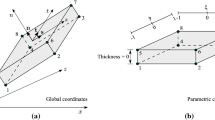Abstract
We present a numerical procedure for elastic and nonlinear analysis (including fracture situations) of solid materials and structures using the discrete element method. It can be applied to strongly cohesive frictional materials such as concrete and rocks. The method consists on defining nonlocal constitutive equations at the contact interfaces between discrete particles using the information provided by the stress tensor over the neighbor particles. The method can be used with different yield surfaces, and in the paper, it is applied to the analysis of fracture of concrete samples. Good comparison with experimental results is obtained.
























Similar content being viewed by others
References
Cundall PA, Strack OD (1979) A discrete numerical model for granular assemblies. Geotechnique 29(1):47–65
Langston PA, Tüzün U, Heyes DM (1995) Discrete element simulation of granular flow in 2D and 3D hoppers: dependence of discharge rate and wall stress on particle interactions. Chem Eng Sci 50(6):967–987
Cleary PW, Sawley ML (2002) DEM modelling of industrial granular flows: 3D case studies and the effect of particle shape on hopper discharge. Appl Math Model 26(2):89–111
Xu BH, Yu AB (1997) Numerical simulation of the gas-solid flow in a fluidized bed by combining discrete particle method with computational fluid dynamics. Chem Eng Sci 52(16):2785–2809
Tsuji Y, Kawaguchi T, Tanaka T (1993) Discrete particle simulation of two-dimensional fluidized bed. Powder Technol 77(1):79–87
Oñate E, Labra C, Zárate F, Rojek J (2012) Modelling and simulation of the effect of blast loading on structures using an adaptive blending of discrete and finite element methods. In: Escuder-Bueno et al (eds) Risk analysis, dam safety, dam security and critical infrastructure management, vol 53. Taylor & Francis Group, London, pp 365–372
Moreno R, Ghadiri M, Antony SJ (2003) Effect of the impact angle on the breakage of agglomerates: a numerical study using DEM. Powder Technol 130(1):132–137
Oñate E, Zárate F, Miquel J, Santasusana M, Celigueta MA, Arrufat F, Gandikota R, Valiullin KM, Ring L (2015) A local constitutive model for the discrete element method. Application to geomaterials and concrete. Comput Part Mech 2(2):139–160
Brown NJ, Chen JF, Ooi JY (2014) A bond model for DEM simulation of cementitious materials and deformable structures. Granul Matter 16(3):299–311
Rojek J, Oñate E, Labra C, Kargl H (2011) Discrete element simulation of rock cutting. Int J Rock Mech Min Sci 48(6):996–1010
Oñate E, Rojek J (2004) Combination of discrete element and finite element methods for dynamic analysis of geomechanics problems. Comput Methods Appl Mech Eng 193(27):3087–3128
Hentz S, Daudeville L, Donzé FV (2004) Identification and validation of a discrete element model for concrete. J Eng Mech 130(6):709–719
Labra CA (2012) Advances in the development of the discrete element method for excavation processes. Ph.D. thesis, Universitat Politècnica de Catalunya, Barcelona
Celigueta MA, Latorre S, Arrufat F, Oñate E (2017) Accurate modelling of the elastic behavior of a continuum with the discrete element method. Comput Mech 60(6):997–1010
Rojek J, Karlis GF, Malinowski LJ, Beer G (2013) Setting up virgin stress conditions in discrete element models. Comput Geotech 48:228–248
Rankine WM (1856) On the stability of loose earth. Proc R Soc Lond 185–187
Belytschko T, Liu WK, Moran B, Elkhodary K (2013) Nonlinear finite elements for continua and structures. Wiley, New York
Labuz JF, Zang A (2012) Mohr–Coulomb failure criterion. Rock Mech Rock Eng 45(6):975–979
www.cimne.com/dempack. Accessed 20 Aug 2019
Dadvand P, Rossi R, Oñate E (2010) An object-oriented environment for developing finite element codes for multi-disciplinary applications. Arch Comput Methods Eng 17(3):253–297
Ribó R, Pasenau M, Escolano E, Ronda JS, González LF (1998) GiD reference manual. CIMNE, Barcelona
Informe de resultados (2015) Fabricación y caracterización de hormigones H30 y H50. Technical report of the international centre for numerical methods in engineering (CIMNE), IT644. Published in Scipedia
http://osp.mans.edu.eg/geotechnical/Ch1C.htm. Accessed 20 Aug 2019
ASTM Standard C496 (2002) Standard test method for splitting tensile strength of cylindrical concrete specimens. ASTM International, West Conshohocken
Acknowledgements
The authors thank Prof. Juan Miquel and Dr. Francisco Zárate for their suggestions during the development of this work.
Author information
Authors and Affiliations
Corresponding author
Ethics declarations
Conflict of interest
On behalf of all authors, the corresponding author states that there is no conflict of interest.
Additional information
Publisher's Note
Springer Nature remains neutral with regard to jurisdictional claims in published maps and institutional affiliations.
Rights and permissions
About this article
Cite this article
Celigueta, M.A., Latorre, S., Arrufat, F. et al. An accurate nonlocal bonded discrete element method for nonlinear analysis of solids: application to concrete fracture tests. Comp. Part. Mech. 7, 543–553 (2020). https://doi.org/10.1007/s40571-019-00278-5
Received:
Revised:
Accepted:
Published:
Issue Date:
DOI: https://doi.org/10.1007/s40571-019-00278-5




